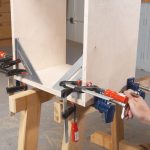We may receive a commission when you use our affiliate links. However, this does not impact our recommendations.
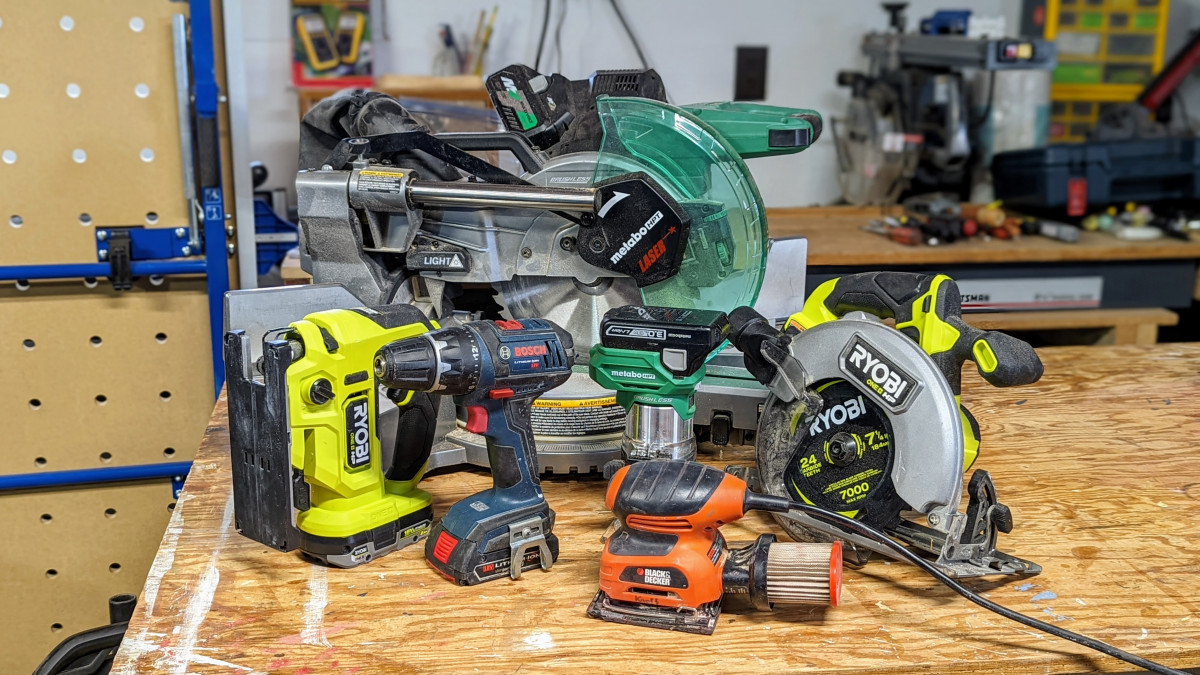
What tools do you need to start your woodworking journey?
“What tools should I buy first?” is one of the more common questions I get from friends who are getting started woodworking. When you look on YouTube, everyone (ourselves included) is using a fully decked-out shop with all the newest, fanciest tools out there, and that tends to set unrealistic standards for what you really need. This guide is to help clear things up a bit and hopefully point you in the right direction.
The tools in the article are ranked in order of how essential I feel they are. A drill might be the most common purchase for a first-time woodworker, but there’s plenty of great furniture made with nails and glue.
If you’re more interested in hand tools, check out the companion piece The Core Hand Tools.
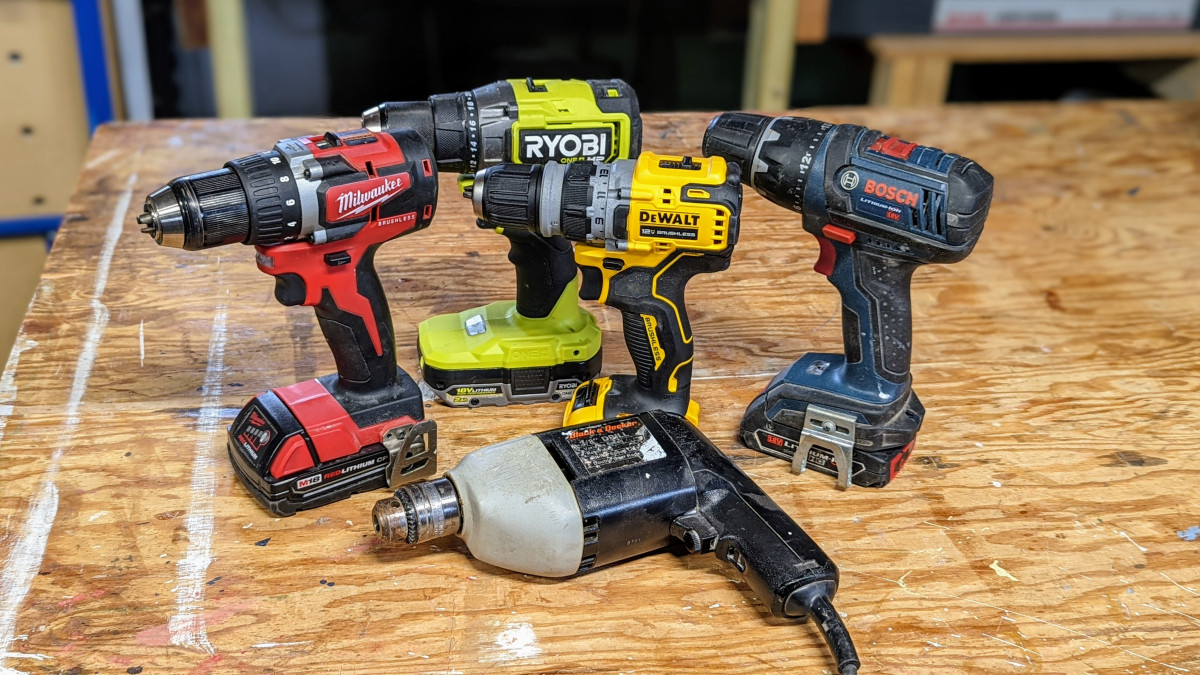
Drills come in a wide variety of brands, sizes, and voltages. Cordless is way more convenient, but it’s not hard to find a corded drill for almost nothing if you’re on a budget.
The Essentials
The four following tools are the only ones I had regular access to for the first few years out of college. Though I was far from a master craftsman I did manage to make bookshelves and built-ins with these tools, and they also came in handy for projects around the house.
- Miter saw: A core tenant of woodworking is the ability to make repeatable, accurate cuts for projects. Few tools make it as easy as the miter saw, which is perfect for crosscutting dimensional lumber (aka the kind you find at most home centers). While any miter saw can make straight or angled crosscuts, I’d strongly recommend spending a bit more on a compound miter saw, which also allows you to make bevel cuts.
- Circular saw: While a circular saw can technically make all of the same cuts as a miter saw, it’s not a particularly accurate tool for repeated crosscuts. Where it does excel is ripping and breaking down sheet goods (aka plywood). With a miter saw and a circular saw, you can make any type of straight cuts in wood.
- Drill: Drills are a shop workhorse; whether it’s making pilot holes for nails, installing hardware, or attaching one of those whisk things to the end to stir paint. While you’ll be perfectly happy with a corded miter saw and circular saw, go ahead and get a cordless drill (one with li-ion batteries) from a reputable manufacturer. The ones on Amazon that seem too good to be true usually kick the can after the first or second use. A 12v drill is more than enough power for most applications and will be more comfortable to use over long periods, but 18v batteries are more common in the power tool world. On that note, it’s worth it to pick a single manufacturer and battery type for most of your tools- the extra batteries and interchangeability will save you time and money long-term.
- Sander: A sander may never be “essential” in the truest sense but it is an essential tool for ongoing woodworking enjoyment. A random orbital sander or a random orbital sheet sander are both good choices, and each has its own pros and cons.
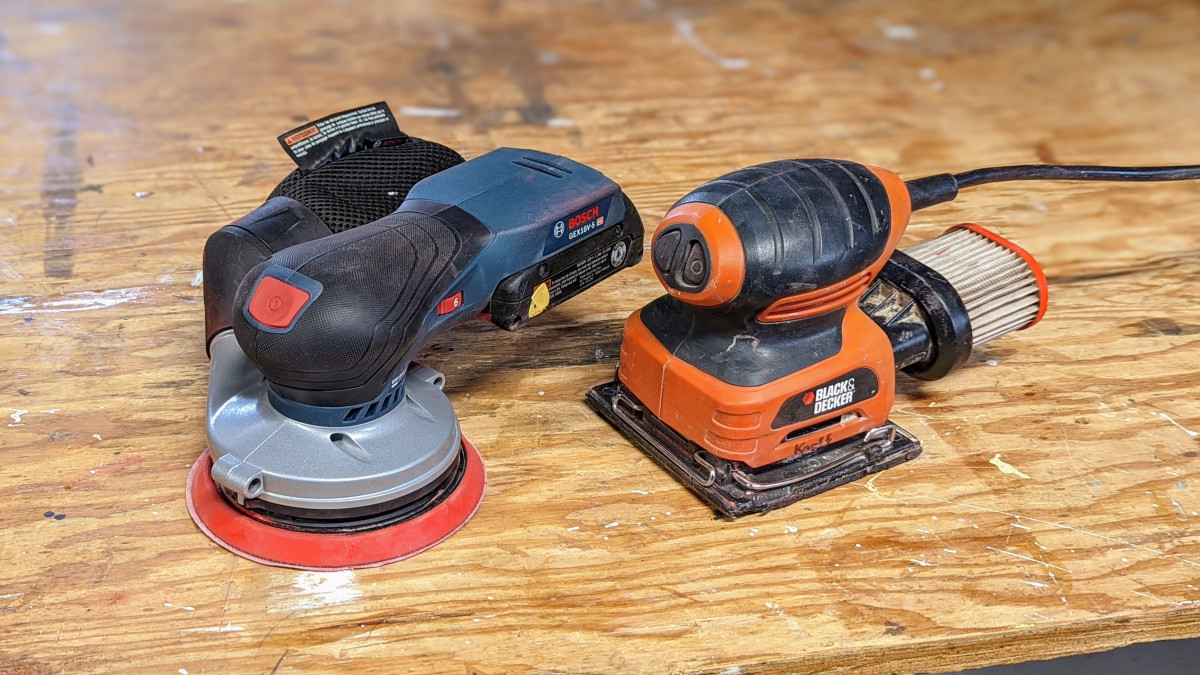
These sanders could hardly be more different, but both are a step up from doing everything with a sanding block.
Beyond the Basics
If you’re ready to move beyond simple birdhouses and bookshelves, you’re going to need a few more tools. These next three tools will dramatically expand the possibilities of what you can make.
- Jigsaw: The saws we’ve featured so far are all designed for straight cuts, but what if you want to throw a curve in there? Enter the jigsaw. While it’s perfectly happy to make rips or crosscuts, the jigsaw is perfect for curved cuts and tight corners.
- Router: Routers are useful for more than rounding edges, as we demonstrate in this video. While it’s easy to fall into the bigger is better trap, most people will find a compact router perfectly adequate for all tasks. A smaller router is also easier to handle and less intimidating to get comfortable with.
- Table Saw: We’re reaching the point of this list where things are shifting from “essential” to the personal preference of each woodworker (see Substitutions below). Table saws have the ability to make all types of straight cuts, and have a wide variety of additional cuts they can make using sleds or jigs. For many woodworkers, this versatility makes the table saw the centerpiece of their shop. Learn more about what the table saw can do here.
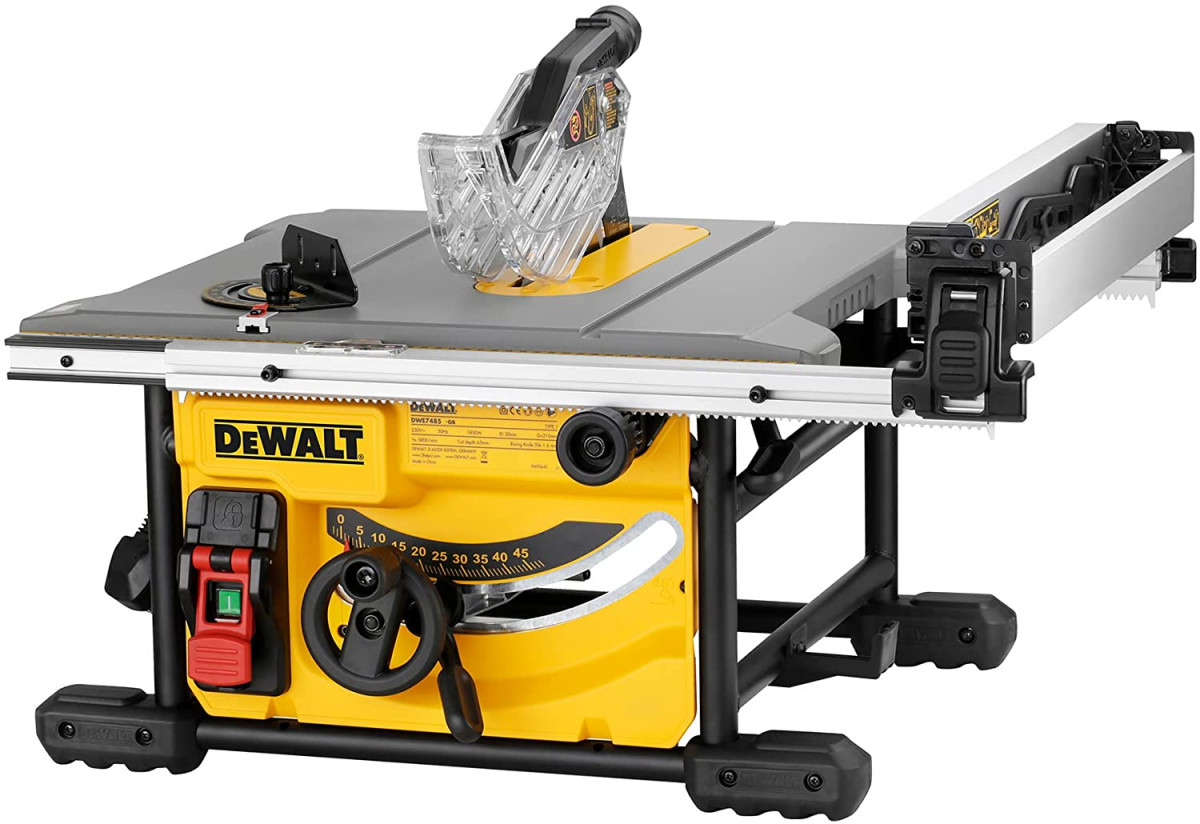
You don’t need to break the bank to get a table saw. A jobsite one like this has almost all the functionality of a full cabinet saw at a small fraction of the cost.
The Next Level
If you have every tool up to this point, congrats! You’re all set to build any I Can Do That project and many more that we publish. The following tools will expand your capabilities and accuracy in your work.
- Band saw: Band saws are great for cutting irregular shapes, as well as resawing lumber. The reason that it’s so far down on this list is the high entry cost for a good model. Unlike some of the other tools on this list, there are huge functionality differences between a benchtop model and the full-sized professional models. However, even inexpensive models will give clean cuts and provide more accuracy and control than what you’d have with a jigsaw.
- Planer and Jointer: While these two tools have different uses, their primary goal is the same: shaping rough lumber. A planer determines the thickness and levelness of the face of a board, while the jointer is usually used to true a flat side or face of board without concern for final thickness. Many woodworkers prefer to use rough lumber as it gives them more control over the final product, and almost always costs less than dimensional lumber.
- Drill Press: The drill press is another tool that excels at accuracy and control. With the ability to make precise adjustments in speed and depth, plus the wide variety of add-ons like mortising bits, the drill press is the cherry on top for the woodworker with a full shop of tools.
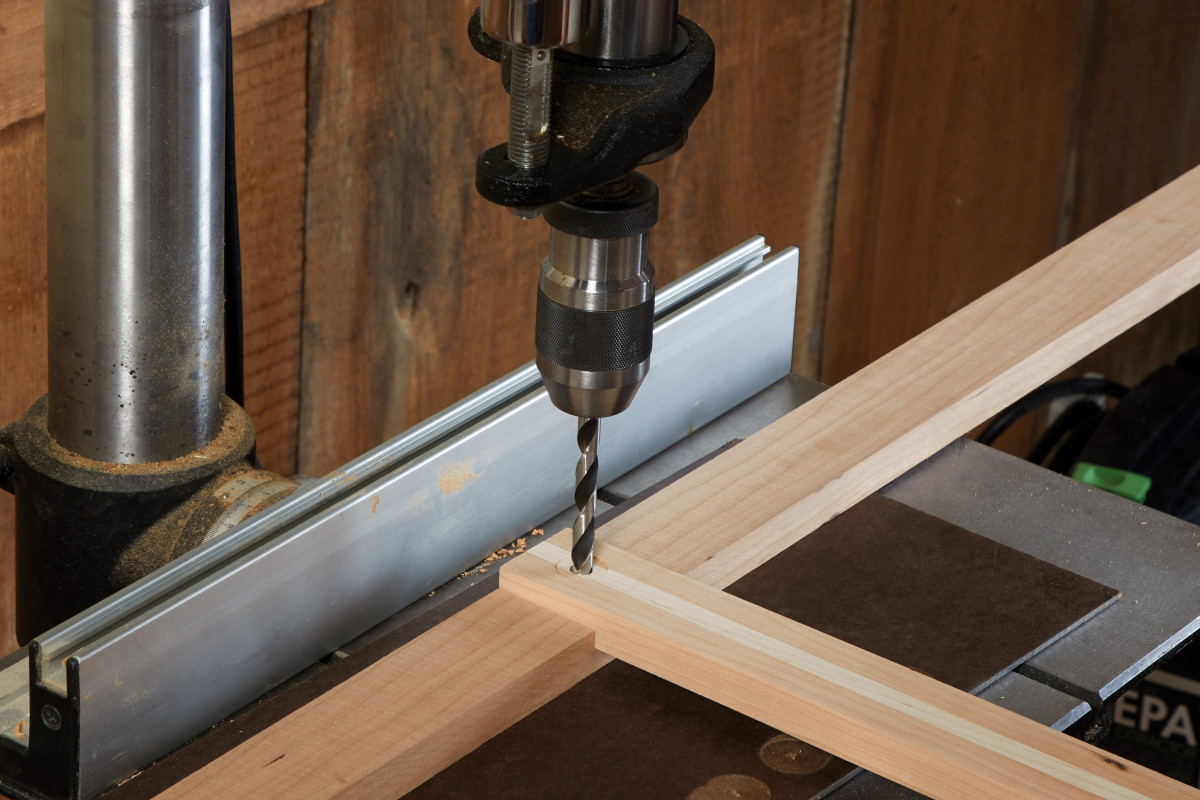
The stability of the drill press makes it easier to bore accurate holes than with a handheld drill.
Substitutions
I’m aware that there are numerous power tools that I haven’t mentioned, but I had to cut the list off somewhere if I wanted to limit it to the core tools. I do want to give a few shout-outs to tools that aren’t quite essential, but provide some of the same functionality if you have access to them. After all, sometimes the best tools are the ones you have right in front of you.
- Track Saw: A track saw is essentially a miter saw that runs on an extruded aluminum track. What that means is that you have a high level of accuracy in a tool that makes any type of straight cut you’d like, even bevels. A setup like the Kreg Adaptive Cutting System can even work as a replacement for many types of table saw cuts.
- Radial Arm Saw: Before the proliferation of the miter saw, radial arm saws were a mainstay of carpenters and home woodworkers alike. Not only can it make straight or angled cuts like a miter saw, but the saw can be rotated 90° to rip boards as well. Why did it fall out of favor? Well, they’re not as accurate as a good miter saw, and they also have the nasty habit of removing fingertips from even the most experienced woodworker. I personally have one in my shop, but it’s a tool I treat with a lot of respect.
- Scroll Saw: Scroll saws are great for cutting tight corners and small details, and can be used in lieu of a jigsaw or band saw if the stock is thin enough.
- CNC: If you have access to a CNC, it can replicate almost any type of cut or bore as the other tools on this list. But, if you have access to a CNC, you probably haven’t read this far into the article anyway.
Here are some supplies and tools we find essential in our everyday work around the shop. We may receive a commission from sales referred by our links; however, we have carefully selected these products for their usefulness and quality.








